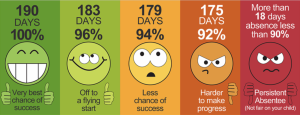Attendance & Punctuality
The school day begins at 8:55am and the school gates are opened at 8:45am and closed at 8:55am. Children are recorded as late if they are not in school ready for registration by 9:10am. All lateness is recorded and monitored, so it is important that your child arrives at school on time.
The school day begins at 8:55am and the school gates are opened at 8:45am and closed at 8:55am. Children are recorded as late if they are not in school ready for registration by 9:10am. All lateness is recorded and monitored, so it is important that your child arrives at school on time.
The beginning and end of the day
Being punctual is as important as good attendance
Pupils need to arrive on time from 8:45 – 8:55am and unless they attend clubs, be collected promptly at 3:30 pm. Any children arriving after 8:55am, or picked up after 3:30pm is late.
From September 2022 pupils in Year 5 and Year 6 may make their own way home with parental consent and agreement from the head teacher. A request for this must be put in writing and given to the Pastoral Manager (Ms Cunningham), this will be reviewed with the class teacher and head teacher before the children is given permission to walk home. Pupils in Year 5 and 6 will not be able to take younger siblings home.
Regular attendance at school is important for your child’s education; however there may be times when your child is too unwell to attend school. To report your child as absent, please fill in the online form using the link below:
https://docs.google.com/forms/d/e/1FAIpQLScG5KumyLAYlF9KrJgdlVifFt1Nti_acAzdUyuxVj5aVEE9Eg/viewform
If your child is absent for more than one day, please remember to fill this form in each morning.
Why is attendance important?

As you can see from the image above, attendance is crucial for your child’s learning. We expect attendance to be at 95% as a minimum and we do not expect children to be late at all. Good attendance at school is not just valuable, it’s essential. Going to school is directly linked to improved learning outcomes which should in turn lead to further opportunities and better job prospects. As well as this, going to school helps to develop:
- Friendships
- Social skills
- Team values
- Good mental health
- Life skills
- Cultural awareness
- Career pathways
What are your legal responsibilities as a parent?
By law, all children of school age (aged four to sixteen) must receive a suitable full-time education. For most parents, this means registering your child at a school or you may choose to make other arrangements to provide a suitable, full-time education. Once your child is registered at a school, you are legally responsible for making sure they go regularly.
How do you ensure your child is successful in school, all day, every day?
- having a routine from an early age and sticking it to it
- making sure your child understands the importance of good attendance and punctuality
- making sure they understand the possible implications for themselves and you as a parent if they don’t go to school
- taking an interest in their education – ask about school work and encourage them to get involved in school activities
- discussing any problems they may have at school and letting their teacher or principal know about anything that is causing concern
- not letting them take time off school for minor ailments or holidays during term time
To avoid disrupting your child’s education, you should arrange (as far as possible), appointments and outings:
- after school hours
- at weekends
- during school holidays
Term time holidays
Term time holidays have been increasing over the last number of years. Parents should make every effort to make sure that their child does not miss school due to holiday plans. Schools are not obliged to agree to you taking your child on holiday during term time. They are entitled to record such holidays as being an unauthorised absence.
Steps we follow to monitor and improve attendance
Illness
If you are not sure how long your child should be off school the table below will provide a guide for you. For more information on an illness or condition and the latest up-to-date guidance please visit nhs.co.uk.
|
Condition |
Recommended period to be kept away from school (once child is well) |
Comments |
|---|---|---|
| Chickenpox | Until all spots have crusted and formed a scab – usually five-seven days from onset of rash
|
Chicken pox causes a rash of red, itchy spots that turn into fluid-filled blisters. They then crust over to form scabs, which eventually drop off. |
| Cold sores | None | Many healthy children and adults excrete this virus at some time without having a ‘sore’ (herpes simplex virus)
|
| German measles | Five days from onset of rash | The child is most infectious before the diagnosis is made and most children should be immune to immunisation so that exclusion after the rash appears will prevent very few cases
|
| Hand, foot and mouth disease | None | Usually a mild disease not justifying time off school
|
| Impetigo | 48 hours after treatment starts and/or until lesions are crusted or healed | Antibiotic treatment by mouth may speed healing. If lesions can reliably be kept covered exclusion may be shortened
|
| Measles | Five days from onset of rash | Measles is now rare in the UK
|
| Molluscum contagiosum | None | A mild condition
|
| Ringworm (Tinea) | None | Proper treatment by the GP is important. Scalp ringworm needs treatment with an antifungal by mouth
|
| Roseolla | None | A mild illness, usually caught from well persons
|
| Scabies | Until treated | Outbreaks have occasionally occurred in schools and nurseries. Child can return as soon as properly treated. This should include all the persons in the household.
|
| Scarlet fever | Five days from child commencing antibiotics
|
Treatment recommended for the affected |
| Slapped cheek or Fifth disease (Parvovirus) | None | Exclusion is Ineffective as nearly all transmission takes place before the child becomes unwell.
|
| Warts and verrucae | None | Affected children may go swimming but verrucae should be covered
|
| Diarrhoea and/or vomiting (with or without a specified diagnosis) | Until diarrhoea and vomiting has settled (neither for the previous 24 hours). Please check with the school before sending your child back. | Usually there will be no specific diagnosis and for most conditions there is no specific treatment. A longer period of exclusion may be appropriate for children under age 5 and older children unable to maintain good personal hygiene.
|
| E-coli and Haemolytic Uraemic Syndrome | Depends on the type of E-coli seek FURTHER ADVICE from the CCDC
|
|
| Giardiasis | Until diarrhoea has settled for the previous 24 hours)
|
There is a specific antibiotic treatment |
| Salmonella | Until diarrhoea and vomiting has settled (neither for the previous 24 hours) | If the child is under five years or has difficulty in personal hygiene, seek advice from the Consultant in Communicable Disease Control.
|
| Shigella (Bacillary dysentery) | Until diarrhoea has settled (for the previous 24 hours) | If the child is under five years or had difficulty in personal hygiene, seek advice from the Consultant in Communicable Disease Control.
|
| Flu (Influenza) | None | Flu is most infectious just before and at the onset of symptoms
|
| Tuberculosis | CCDC will advise | Generally requires quite prolonged, close contact for spread on action. Not usually spread from children.
|
| Whooping cough (Pertussis) | Five days from commencing antibiotic treatment | Treatment (usually with erythromycin) is recommended though non-infectious coughing may still continue for many weeks
|
| Conjunctivitis | None | If an outbreak occurs consult Consultant in Communicable Disease Control
|
| Glandular fever (infectious mononucleosis)
|
None | |
| Head lice (nits) | None | Treatment is recommended only in cases where live lice have definitely been seen
|
| Hepatitis A | See comments | There is no justification for exclusion of well older children with good hygiene who will have been much more infectious prior to the diagnosis. Exclusion is justified for five days from the onset of jaundice or stools going pale for the under fives or where hygiene is poor
|
| Meningococcal meningitis/septicaemia | The CCDC will give specific advice on any action needed | There is no reason to exclude from schools siblings and other close contacts of a case
|
| Meningitis not due to Meningococcal infection
|
None | Once the child is well infection risk is minimal |
| Mumps | Five days from onset of swollen glands | The child is most infectious before the diagnosis is made and most children should be immune due to immunisation
|
| Threadworms | None | Transmission is uncommon in schools but treatment is recommended for the child and family.
|
| Tonsillitis | None | There are many causes, but most cases are due to viruses and do not need an antibiotic. For one cause, streptococcal infection, antibiotic treatment is recommended
|
| HIV/AIDS | HIV is not infectious through casual contact. There have been no recorded cases of spread within a school or nursery.
|
|
| Hepatitis B and C | Although more infectious than HIV, hepatitis B and C have only rarely spread within a school setting. Universal precautions will minimise possible danger or spread of both hepatitis B and C.
|
|
